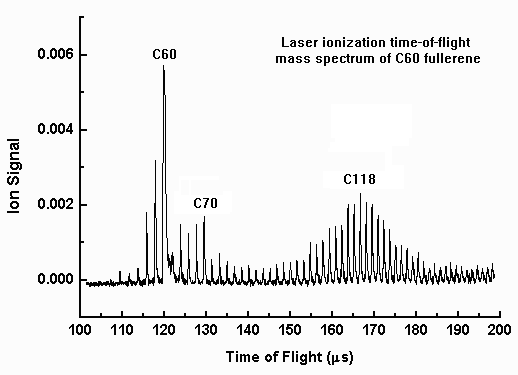
The mass of C60 is 720 amu (fullerene mass spectrum courtesy of Craig Watson, Virginia Tech).
A time-of-flight mass spectrometer uses the differences in transit time through a drift region to separate ions of different masses. It operates in a pulsed mode so ions must be produced or extracted in pulses. An electric field accelerates all ions into a field-free drift region with a kinetic energy of qV, where q is the ion charge and V is the applied voltage. Since the ion kinetic energy is 0.5mv2, lighter ions have a higher velocity than heavier ions and reach the detector at the end of the drift region sooner.
Example of a TOF mass spectrum

The mass of C60 is 720 amu (fullerene mass spectrum courtesy of Craig Watson, Virginia Tech).
K.E. = qV
1/2 mv2 = qV
V = (2qV/m)1/2
The transit time (t) through the drift tube is L/V where L is the length of the drift tube.
t=L / (2V/m/q)1/2
Schematic of a reflectron TOF-MS

This schematic shows ablation of ions from a solid sample with a pulsed laser. The reflectron is a series of rings or grids that act as an ion mirror. This mirror compensates for the spread in kinetic energies of the ions as they enter the drift region and improves the resolution of the instrument. The output of an ion detector is displayed on an oscilloscope as a function of time to produce the mass spectrum.
[BACK]